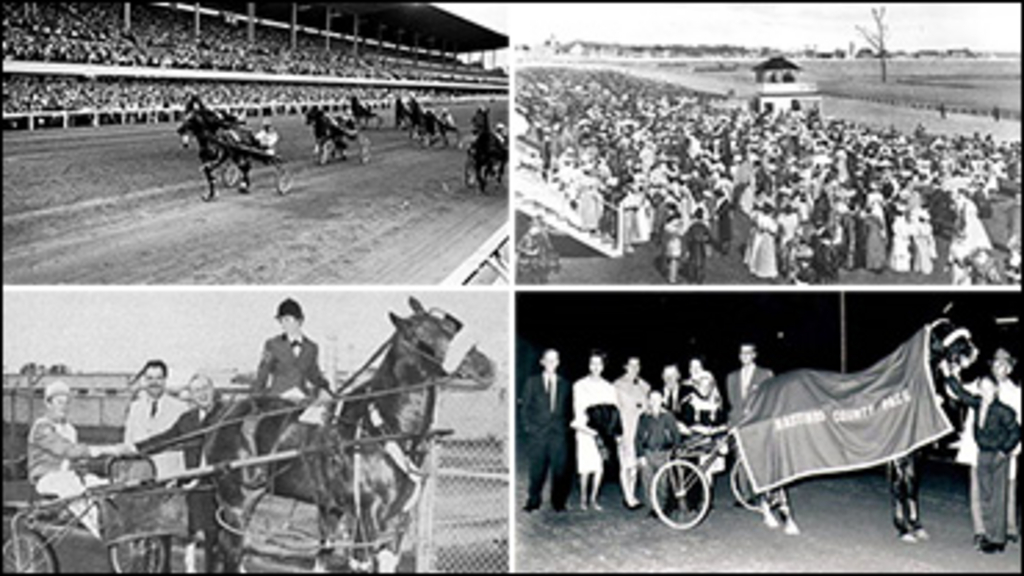
In the current edition of SC Rewind, Robert Smith presents the third and final part of a previous feature titled The First To Be First. His piece traces the start up of many racetracks across Ontario; with each containing a short commentary about their opening day. Personal memories are always welcomed; thanks for your input on Parts I and II.
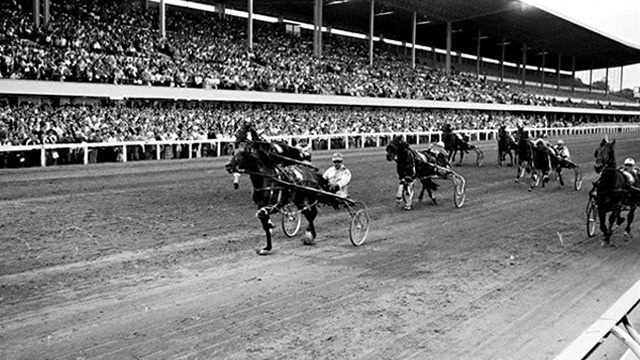
A field of horses head down the stretch at Old Woodbine on July 1, 1961 as night racing began. The huge crowd can be seen in the background, with a full grandstand and a large gathering on the apron.
Old Woodbine / Greenwood - Toronto, Ont.
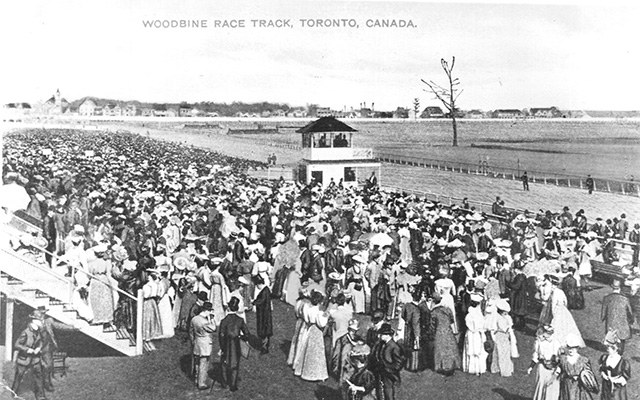
The Woodbine track as it appeared in the very early years
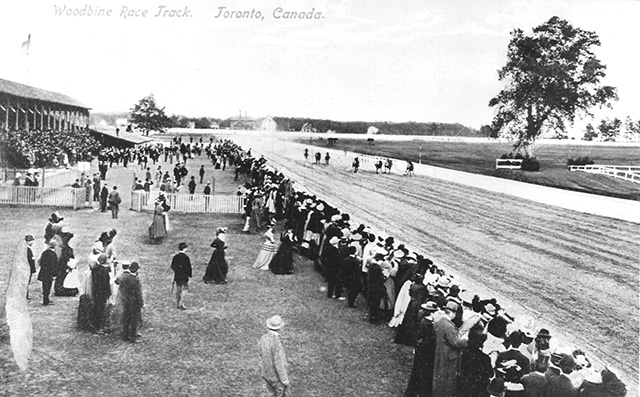
?
This track dates back to the 1800's and during its lengthy history it hosted various types of racing including thoroughbreds, steeplechase and harness racing. Its best known era started in 1954 when Thorncliffe Park was closed and summer harness racing moved to this location. It annually grew in popularity and was gradually transformed into one of the most visited and revered racetracks on the planet known as Greenwood.
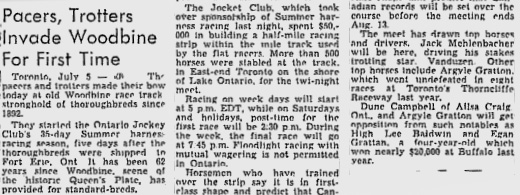
Monday, July 5, 1954 marked the opening day of harness racing at the Old Woodbine track in Toronto and the first meeting lasted 35 days. Six races, two double dashes and four single dashes filled the card, making a day of eight heats. Night racing was not yet allowed in Ontario so post time had to occur at a time that ended prior to darkness. Twilight races were often held at this track as well as matinées when post time was 4:30 p.m.
There were two feature races on opening day, both carded as Class 18 Conditioned Pace. The first was won in two straight heats by Lenas Boy driven by Lloyd Turvey for owner Reg McGee, a Goderich auto dealer, in a speedy 2:13. In the second feature, the four-year-old mare Evelyn G Dillon was home first in both heats, the quickest in 2:15.2. The Dillon Mc sired miss was owned by Jack Goyette of Hamilton, Ont. and very capably driven by Almer Holmes. Day One was in the record books; many more were to follow.
For many the nostalgia of the Greenwood era will forever be etched in their minds; the very mention of the place stirs up special memories. The times were good, the racing was superb and many say the beef on a bun has never been equalled. I had the pleasure of being there with my late father when night racing first began and I even slept overnight in a tack room where the company was great and the nightly rates even better!
Orangeville Raceway - Orangeville Ont.
Harness racing at the Orangeville fairgrounds goes back as far as history has been recorded in this Dufferin County Town. A famous man of the area named Dr. Henry Riddell, a local veterinarian, was active in the staging of races for many years. It was truly located in a veritable hotbed of harness racing. The modern day version of racing began in 1970 when a team headed by Keith and Murray Waples upgraded the facility and staged weekly racing for many years.
Opening day was Sunday, May 3, 1970 and it marked the first of 18 consecutive Sunday cards that first season. Many well-known drivers were on hand to help launch the opening of the Dufferin County track, due in large part to the persuasive powers of Keith and Murray Waples. The first ever race was won by a horse named Jack Honers owned and driven by Bill Carroll, a fellow who was born and raised not too far away from here at Riverview. Second was 12-year-old Innocent Bob for Ray Gemmill with third spot going to Paul's Signal.
Purses on opening day ranged from $200 to a high of $600 for the Free For All Pace won by Piper Herbert and driver John Hayes, who was followed in second spot by Jet Adios and Jack Gordon. A few other winning drivers on that day included John Murphy, Reg Lipsett, Brent Davies, Andy Avery, Carman Hie, Joe Truckle, George Wain. Veteran Jimmy "Red " Holmes closed out the day with a victory behind Glenholme Joe. By the end of May, two races were held which each carried a purse of $1,000 and both were won by Barbara D Pride driven by Retta Herrington for owner Hilliard O'Connell of Roseneath, Ont.
Known as the ‘Dean of Ontario Harness Racing,’ Orangeville veterinarian and former town mayor, Dr. William Henry Riddell, played a pivotal role in the province’s harness racing history. With large numbers of horses conscripted to the First World War, quality Standardbred racehorses were on a decline. Riddell began breeding horses with proven lineages and shared his resources, which allowed racehorse stables across Ontario to thrive. Never married to my knowledge, he was known to drive a horse called The Bison to make his vet calls. Local legend had it that he was known on occasion to pay a visit at the odd young lady's residence while making his rounds.
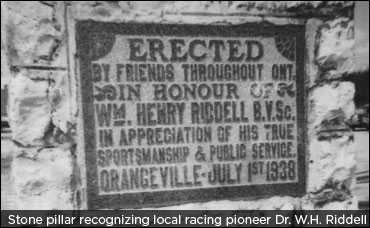
In 1938, Dr. Riddell, who had privately sponsored races by offering generous purses for many years, was honoured with a stone plaque at the main gate of Orangeville's Exhibition Park. (Photo courtesy of Barbara Lennox)
Rideau Carleton Raceway - Ottawa, Ont.
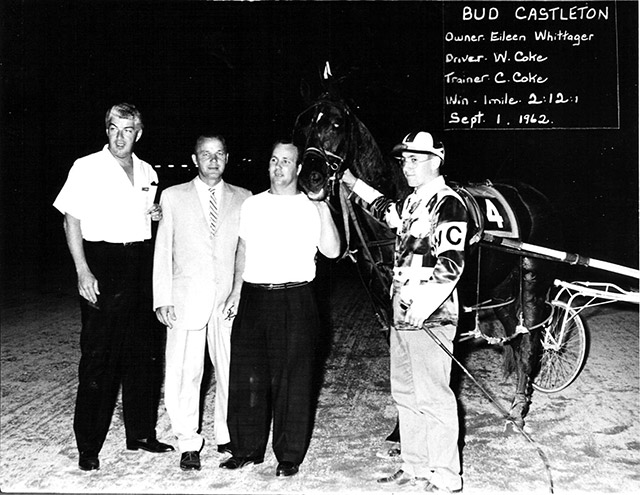
L-R: Darrel Simpson, Raceway Chief Jim Baskin and co-owner Bill Campion join driver Wes Coke and first race winner Bud Castleton in the winner's circle as Rideau Carleton starts operations in 1962.
This track was the first brand new track in Canada built exclusively for harness racing in the 20th century. It was also the first new track built in Ontario during the decade of the 1960's, followed by many more as night racing finally came to the Province in 1961.
Sept. 1, 1962 - With a packed grandstand looking on, starter Tom McDonnell sent away a field of eight pacers in the new track's first ever race. With a purse of $400 on the line, the winner was the eight year old gelding Bud Castleton stopping the brand new timer in 2:12.1. The winning driver was Wes Coke, a young lad from Petrolia, Ont. who had just turned 19 about a month previous to this evening. Co-owner Bill Campion was on hand to have his picture taken along with a friend and Raceway chief James Baskin.
On opening night the only double winning driver was Dr. John Findley of Arnprior who annexed both features with Palermo and Chief Canuck, also finishing second with Lexie Herbert, all from his quality stable. Other winning drivers included Allan Waddell (just 18 at the time), Yvon Plouffe, Wm. Pyke, Neil Curran and westerner Jim Wiener. The honour of recording the night's fastest mile went to driver Claude Miville, who piloted the venerable 13-year-old veteran Cracker Jack in a time of 2:07, thus establishing the first track record.
Shown below is a bit of early action as a number of local horses and horse people found the new track quite to their liking. The winner was owned by Hector Clouthier of nearby Pembroke, Ont.

Northwood Alex is shown with a smiling circle of followers after setting a track record of 2:05.2 for three-year-old pacers at Rideau Carleton. This photo was taken just two weeks after the track opened. From left: John Thompson, Mrs. Thompson, Molly Clouthier, Hector Clouthier Jr., Hector Cloutier Sr., Harvey Gallagher (driver), Teresa Giesebrecht, Paul Thetford and at the horse's head Edwin Schreader and Tom Clouthier. Be sure to take a close look at that young fellow right next to the driver.
Sudbury Downs - Sudbury, Ont.
This far northern track opened its doors for live harness racing on June 2, 1974. The first race was won by Pink Panther, driven by Jim Wallace and stopping the timer in 2:10. A wide variety of horsepeople competed during that first year including those from Eastern Ontario and Quebec. The opening year coincided with the first season of O.S.S. competition which saw a rather large number of well-known horsemen paying a visit. Included among them was Keith Waples.
A gentleman who would later occupy a special place in Canadian harness racing history actually got his start at the Sudbury track. Frank Salive, one of the sport's all time great race callers, began his career there in the mid 1970's. As a fledgling reporter and announcer at the local CKSO radio and T.V. station he was given a chance to try his hand at race calling by track operators Pat MacIsaac and Ken LeDrew. Most people know how that experiment worked out.
The Sudbury track was located in what was once known as Boninville which is now part of greater Sudbury between Azilda and Chelmsford. A casualty of the overall decline of Ontario harness racing Sudbury Downs closed on October 30, 2013, almost 40 years after its grand opening.
Thorncliffe Park - Toronto, Ont.
This very old track existed for many years in the Toronto neighbourhood of Leaside prior to its final renaissance which occurred in July of 1950 with opening day on July 3rd. The stately old track was refurbished and retrofitted for harness racing. The first race in its updated 'life' was won by Dr. Rice, owned by Parker Locke of Williamsburg, Ont. and driven by the well-known horseman of yesteryear Cecil Champion. This gentleman, who raced at the large tracks in the U.S. for many years, was originally from Penatang, Ont.
Opening day consisted of eight races; five were single-heat affairs with a generous purse of $500. The two features were double heats and went for $1,125. Other winning drivers on the inaugural card included Honorat Larochelle, Harold McKinley, Eric Conley, Wilfy Hughes, Wilbert Hopkins, Henry Corcoran and Jack Herbert. The best winning time for a mile was turned in by Lucy Lester for Henry Corcoran when they stopped the timer in 2:11.
During its relatively short four-year existence, the track was the scene of a number of memorable races and the beginning of the great Maple Leaf Cup Trot which continues to this day (minus the "Cup"). A companion race for pacers called the Canada Cup also attracted the best available talent around. A number of the sport's best horsemen competed during the Thorncliffe era. Keith Waples, Dr. John Findley, Harold Wellwood, Marshall Moore, Bill & Jack Herbert, Honorat Larochelle, Phil Dussault, Cliff Hie, Jack Gordon, Bill Habkirk, Jack Mehelenbacher, Vic Rowntree, the Chapmans, Rowes, James and many more were names of the day.
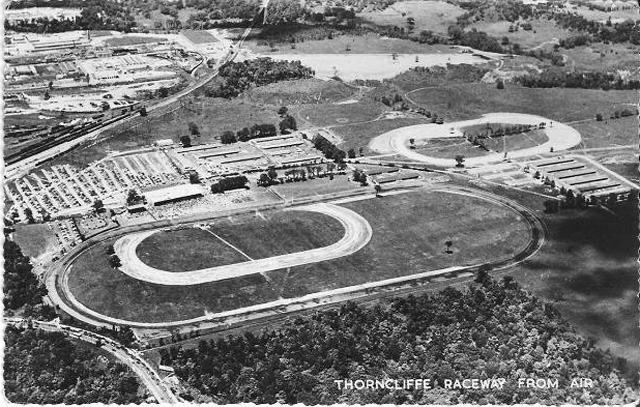
An aerial view of Thorncliffe Park
Thorncliffe's opening signalled the start of extended race meetings in Ontario. After four years of summer meets at Thorncliffe the track was closed and racing moved to Old Woodbine which later became Greenwood. These four years were "growth" years for the sport in Toronto as fans were introduced to pari-mutuel betting, single-heat racing, the mobile starting gate and all around better facilities.
Windsor Raceway - Windsor, Ont.
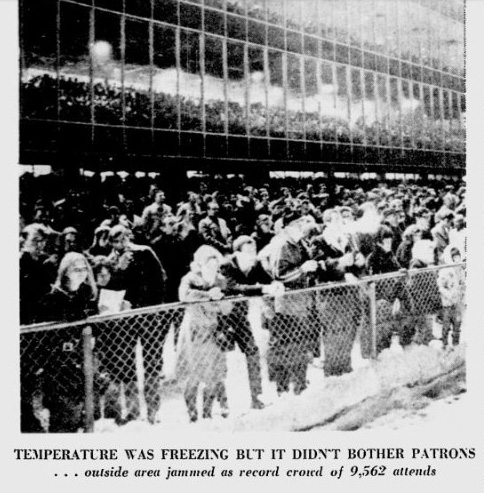
A typical huge crowd fills the Windsor track during the early years despite frigid temperatures (Windsor Star Photo)
In the fall of 1965 a new state of the art facility designed to host winter time racing was opened at the west end of Canada's most southerly city. The opening night was held on Thursday, October 22, 1965 and the very first race was won by a horse named Castle Direct, driven by Fred Roloson, a native of the Tillsonburg, Ont. area. After a ten-year hiatus with no winter time racing after the 1955 closing of Dufferin Park in Toronto, Windsor Raceway opened. It featured a synthetic Tartan track that was virtually unaffected by the weather. As patrons entered the grandstand they immediately felt a different terrain beneath their feet. They soon figured out that they were walking on the very 3M tartan upon which the horses were racing. The cost of the track installation was said to be around $1 million while the total price tag of the facility was estimated at $5.5 million.
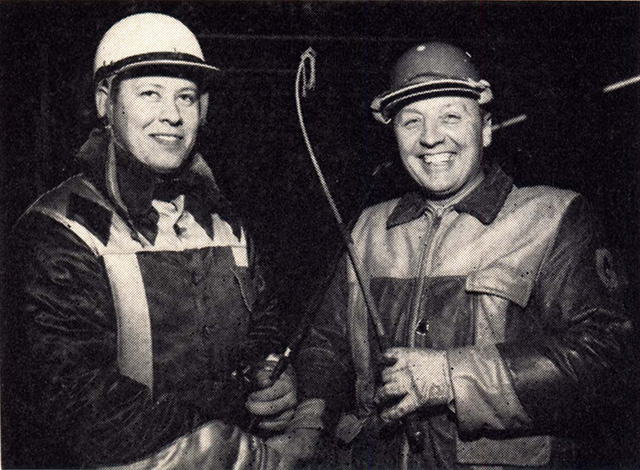
A couple of familiar faces from the early days at Windsor. On the left is Gerry Bookmyer of Sycamore, Ohio and on the right "Smilin'" Freddy Goudreau of Croton, Ont. (Harness Horse)
The stables were all insulated with special tack rooms designed to house the backstretch personnel in relative comfort. Each barn was fully equipped with hot water wash areas and telephones connected each section of the barn area with the race secretary's office. A modern track kitchen provided food for the track residents and an upper floor viewing room adjacent to the paddock provided an excellent view of the races. A second track in the backstretch area provided an extra spot especially for morning jogging.
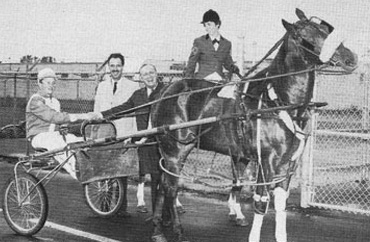
A rather unique part of the opening night ceremonies occurred in the afternoon of opening day. Horseman John Sutherland drove a horse across the Ambassador Bridge. It was intended to symbolize the closeness of the two Countries as well as the transfer of the racing season from Michigan to Ontario. On hand to greet the former Maritimer Sutherland and his horse, were Raceway officials Vice President Wm. Rowe and President Al Siegel, as well as parade marshal Helen Derenoski.
The entire Windsor operation was designed and built for winter racing. With a large population of both Canadian and U.S. fans nearby, the new track was an instant success. Never before in Canada was it possible for fans of harness racing to attend races in comfortable surroundings during the dead of winter. The times were right; the sport was at its absolute peak. Unfortunately what many remember is the end which was a sad time in our sport's history. Today just a sign or two and a few remnants of the past remain to remind us of what was truly the golden age of Canadian harness racing.
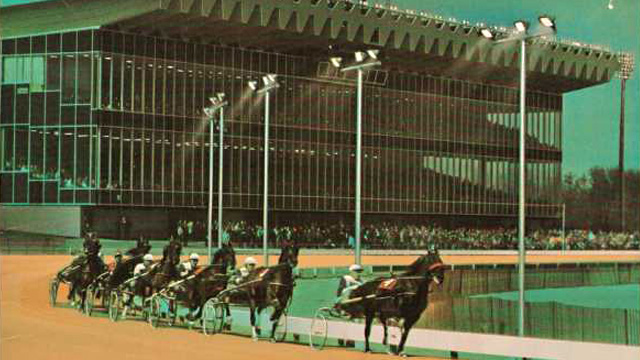
For many years the above scene graced the front of the Windsor official program.
Closing Notes: This three-part story has just barely scratched the surface. For several generations of Canadian racing fans racetracks were very special places; be they large and grandiose or plain and simple. People gathered there, they enjoyed the action and precious memories were made. For those who put on the show, it was where they lived and spent their days. Their place in history may wane but hopefully never be forgotten.


I came into the industry off
I came into the industry off the betting floor. By 1974 we were racing a claimer at Orangeville, often on Sunday afternoon. One minute to post was a generalization as some how the mutuel manager could signal the starter to keep the horses circling until the long lines got their bets placed. Jim Keeling, another car dealer, was also instrumental in the opening. He had previously sponsored the Owen Sound Mercurys who won the Allan Cup in 1951. Several players from that team including Doug Gillespie and Tom Burlington came along to help in the early days. Owen Sound native Harry Lumley, a famous NHL goalie, was the assistant starter.
Thank you Leon for that
Thank you Leon for that brilliant piece of trivia; it is much appreciated. After all these years of wondering who that was I now find out. I have known of Mr. Hoyt for eons and certainly recall Imperial Lee (by Castle Lee). He was always a London favourite and kept racing until age 14.
A few years ago (2015) I devoted a Rewind to car dealers in the horse business; sorry Mr. Hoyt's name was not on the list.
Here's some trivia Robert.
Here's some trivia Robert. The trotter in the lead on the cover of the Windsor program was Imperial Lee driven by Clarence Hoyt. Mr. Hoyt was a Chrysler dealer in my home town of Norwich and he named this horse after the Chrysler Imperial car.
GREAT article Robert ! It
GREAT article Robert ! It really helps for you to jerk us seniors memories of so many of these great tracks and great people.